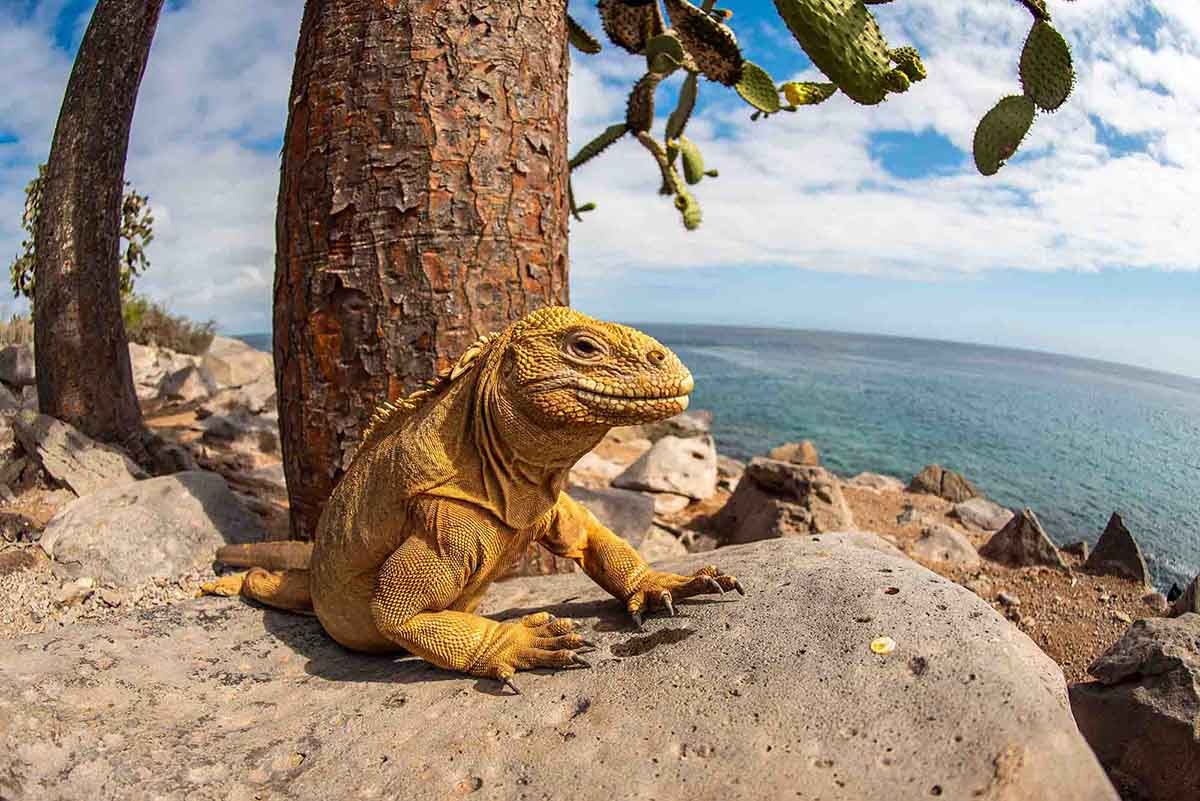
After 200 years the land iguanas are back to Santiago Island | Travel Blog
Welcome back Iguanas! More than 1400 iguanas were recently reintroduced to Santiago island in the Galapagos. The last known person to ever record the iguanas in Santiago island was no other than Darwin himself. Although Darwin’s assessment of the aesthetics of the iguanas was less than cheerful, calling them ‘ugly animals’, the rest of us excited to see the mighty reptile finding its way back home.
After a 200 years absence the yellowish Galapagos Land iguana is back to stay. The initiative is the result of a collaboration between the Galapagos National Park, the Massey University from New Zealand, and the Conservation Institute. A team of 25 park rangers were involved in the execution of this four-stage project.
Initially, the iguanas were captured in Seymour North island, where they are more plentiful, and presently relocated to the neighboring Santa Cruz island. Here, they underwent health checks to ensure their quick and easy acclimatization to their new home at Santiago island. The team held the iguanas captive for four weeks to make sure no seeds in their guts would transfer from Seymour North island to Santiago island.
On January 3rd and 4th of this year the land iguanas were finally released in the coastal regions Puerto Nuevo and Bucanero in Santiago island. These two areas offer an ecosystem similar to that of their natural habitat and they are also surrounded by abundant vegetation rich in the savory cacti iguanas are so fond of. If that was not enough, the new iguana settlers will not have to face the same threats that wiped out their ancestors centuries ago.
 Back when Darwin was reporting on iguanas in Santiago island mariners and early settlers began introducing domestic animals to the environment. Over time these animals either escaped or were abandoned to the detriment of the land iguana. Goats competed with the reptile for food and cleared large areas of vegetation the iguana relied on. Cats and dogs hunted young and adult iguanas while other foreign animals preyed on their eggs.
Back when Darwin was reporting on iguanas in Santiago island mariners and early settlers began introducing domestic animals to the environment. Over time these animals either escaped or were abandoned to the detriment of the land iguana. Goats competed with the reptile for food and cleared large areas of vegetation the iguana relied on. Cats and dogs hunted young and adult iguanas while other foreign animals preyed on their eggs.
Yet, the major culprit for the iguanas’ demise was the feral pig. Gone wild, the omnivorous pig relentlessly decimated the island’s ecosystem leaving very little for the Santiago island iguanas. Eventually the iguanas disappeared from the island never to be seen again. Fortunately, the National Park has since controlled the widespread of large animals, including the pig, that contributed to the massive destruction of island’s ecosystem. Santiago island is now pig free and iguana-friendly since 2006.
Besides re-populating Santiago island the Park’s initiative will also benefit the ecosystem of Seymour North island. Around 5000 iguanas populated Seymour North island before being relocated. The large number of iguanas had become a burden to the ecosystem, particularly to the cacti vegetation. Reducing the iguana population will have positive results both for the native vegetation and for the iguanas who will have less competition and more food resources available.
In February the last stage of the project will start. Once the iguanas have settled in their new home the team will monitor how they have adapted to the environment and if nests have been established — a good sign that iguanas are comfortable enough to start reproducing. Other valuable information for the team include the types of plants iguanas are eating and identifying their mechanisms of survival. Additionally, the team will remain vigilant of the rodent and ant species in the island to ensure the safety of the iguanas’ nesting areas.
The authorities of the Park are committed to the success of the project. Jorge Carrión, director of the Park, praised the project emphasizing that it will “guarantee the ecological integrity of Seymour North and a successful establishment of land iguanas in Santiago island.” Likewise, Dany Rueda, the park authority’s ecosystems director, highlighted the valuable role of land iguanas helping the ecosystem “by dispersing seeds and maintaining open areas free from vegetation.”
In other words, they may not be the prettiest, but land iguanas certainly help the Enchanted Islands remain enchanted.
If you want to see land iguanas in the Galapagos Islands, check out these itineraries:
Check Our Suggested Tours:
- Itinerary East Galapagos
- Elite Catamaran 5 day luxury cruise Galapagos north islands
- 8 Day Galapagos Cruise: Explore Nature's Paradise
- Central & North 8-Day Galápagos Cruise
- Elite Catamaran Galapagos Islands luxury cruise 8 days eastern & western route
- Galapagos Luxury Cruise: Unforgettable Adventures in Ultimate Comfort
Check Our Galapagos Cruises:

